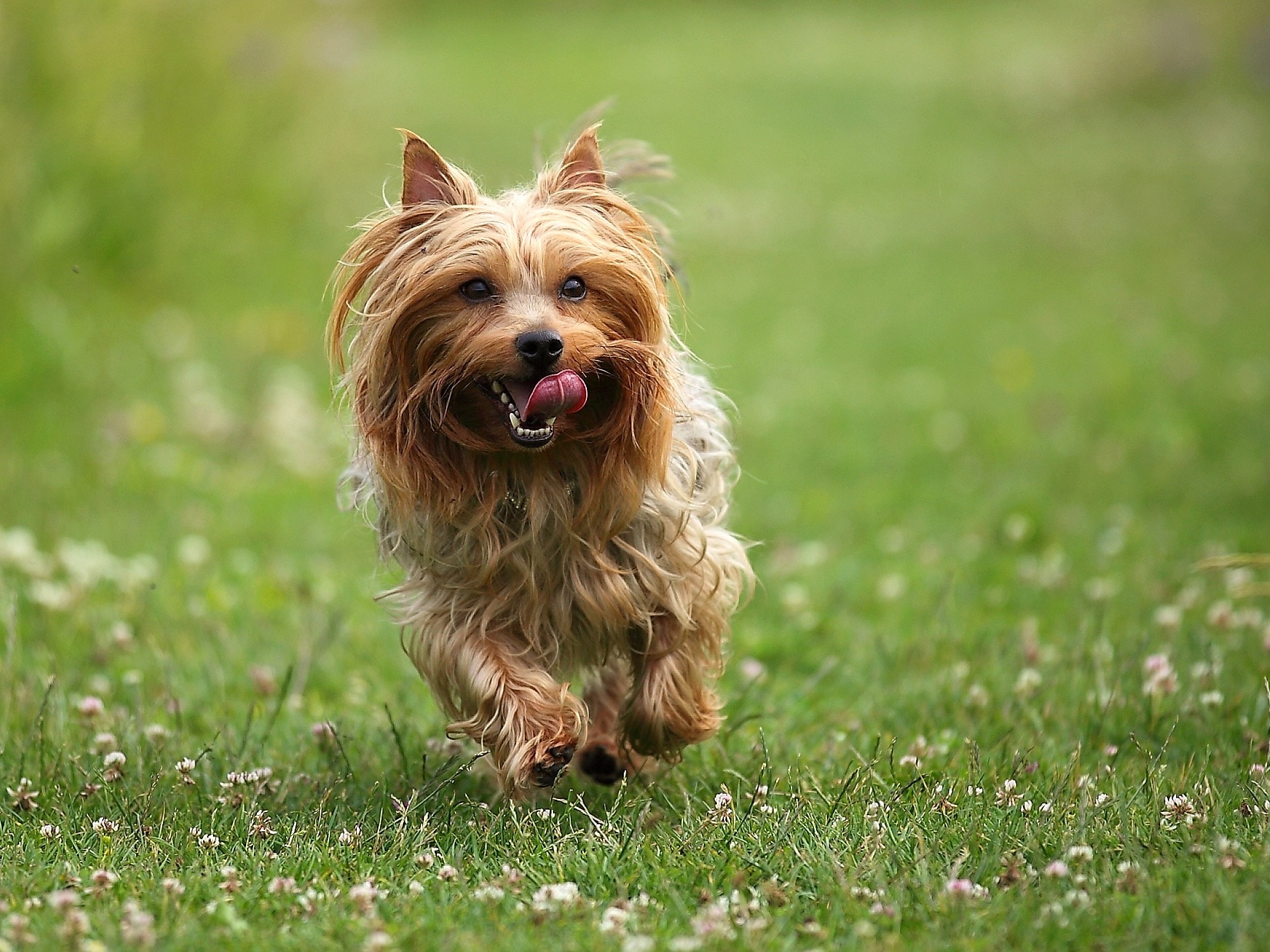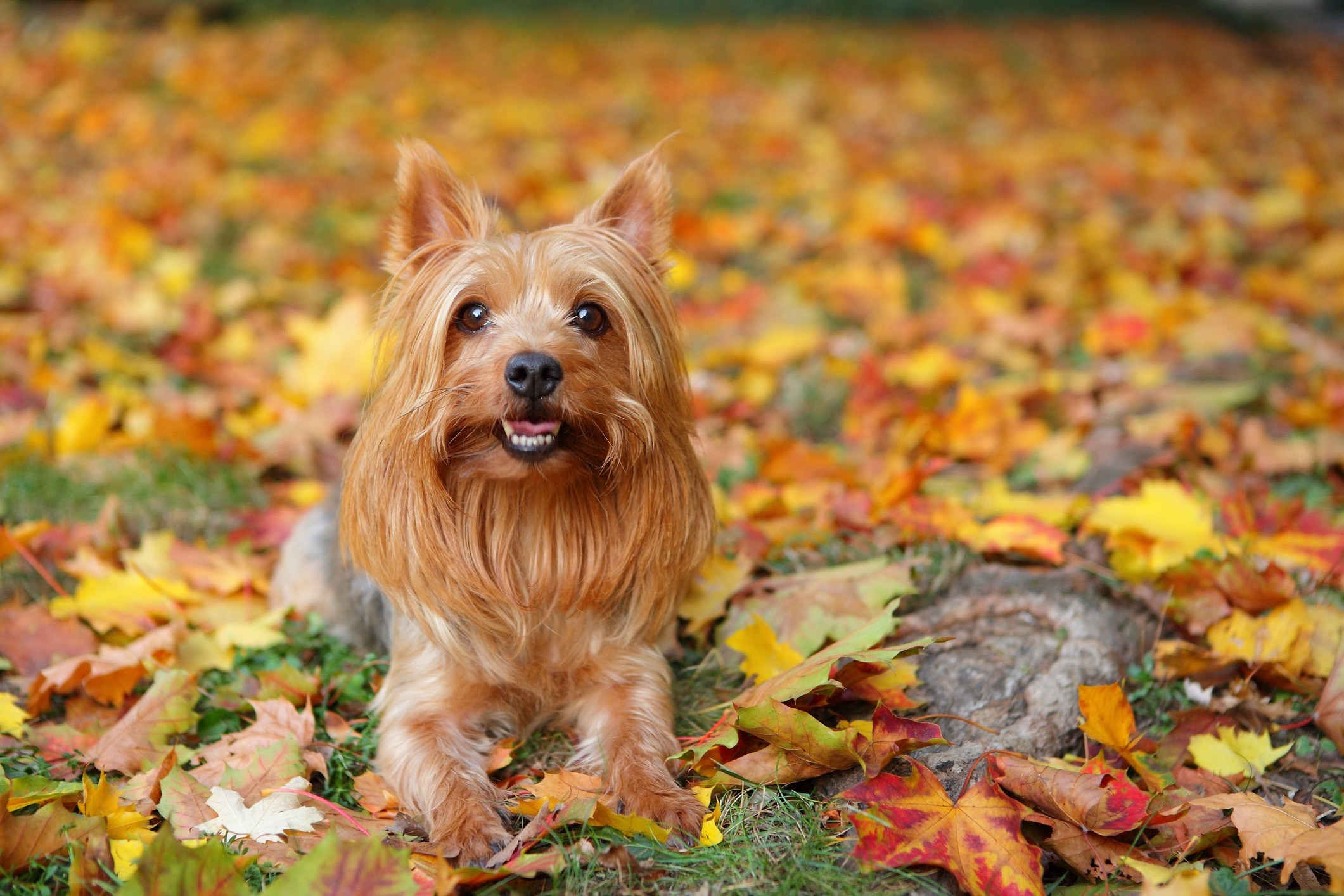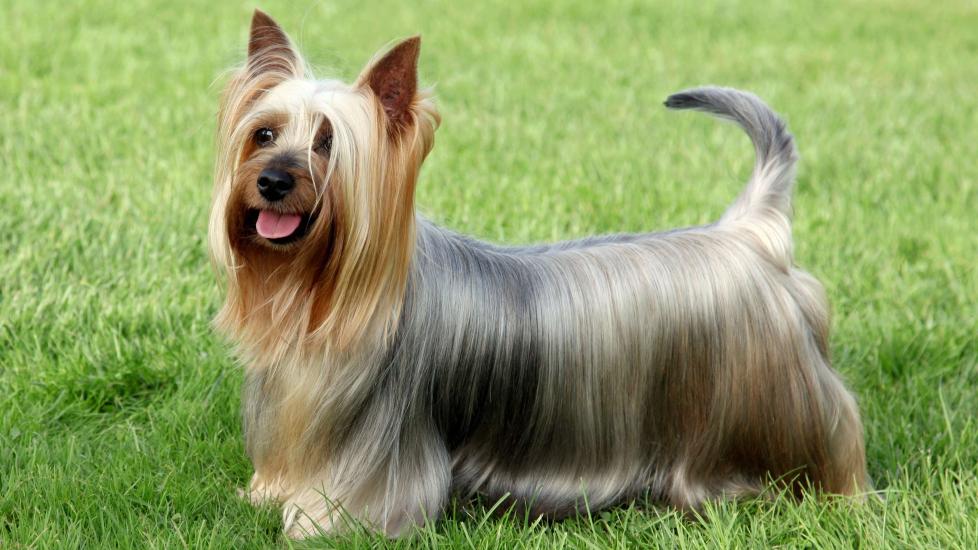Silky Terrier
Adobe Stock/Vincent
In the early 1900s, native Australian Terriers were bred with imported Yorkshire Terriers to create the Silky Terrier. This breed is an affectionate, high-energy toy terrier that has long blue and tan silky fur, a wedge-shaped face, and V-shaped ears that stand erect.
Silky Terriers stand 9–10 inches at the shoulder, which is taller than the Yorkshire Terrier (which reaches up to 8 inches tall). This breed weighs in at around 10 pounds, and the Silky Terrier’s lifespan is 13–15 years.
Caring for a Silky Terrier
Silky Terrier dogs are loyal companions to their family members and are full of affection and energy. This breed needs at least one hour of exercise daily to be happy, such as a long walk or maneuvering through an agility course.
Along with daily exercise, Silky Terrier dogs need a lot of attention paid to their long, glossy hair. Silkies need to be brushed at least twice a week to prevent matting. Because their hair grows continuously, professional grooming appointments are often needed to keep their hair trimmed to an appropriate length.
Silky Terrier Health Issues

Silky Terriers are relatively healthy dogs. But like all dogs, they can develop some health issues throughout their long life.
Cataracts
A cataract is a cloudy lens within the eye. Small cataracts are only visible with the aid of an ophthalmoscope, while large cataracts can be easy to see, as the pupil will look completely white. The larger the cataract, the more significant the loss of vision.
Cataracts are usually hereditary, so breeders should not breed Silky Terriers with a family history of this eye condition. Surgery to remove the cataracts and restore eyesight is an option.
Progressive Retinal Atrophy
Progressive retinal atrophy (PRA) is an inherited disease in which a genetic mutation causes the eye’s retina to slowly degenerate, leading to blindness. Affected Silky Terriers are usually diagnosed between 3–9 years of age. There is no cure for PRA, but blind Silky Terriers can still live long, happy lives with proper care.
Dental Disease
Caused by the buildup of tartar and calculus, dental disease can develop quickly in Silky Terriers. Bad breath, tooth root abscesses, and loss of teeth can occur if at-home dental care and professional dental cleanings are not provided.
Silky Terrier dogs with significant dental disease may have difficulty chewing, prefer to eat only canned food, or stop eating altogether. A vet should perform an oral exam every six to 12 months to determine whether a professional dental cleaning is needed. Talk with your veterinarian to find out what at-home dental care products are best for your Silky.
Liver Shunt
A portosystemic (liver) shunt is a blood vessel that shunts blood away from the liver, causing the liver to be abnormally small (microhepatica). This condition is believed to be hereditary in Silky Terriers.
Symptoms include:
-
Stunted growth
-
Failure to thrive
-
Pacing
-
Muscle tremors
-
Head pressing
-
Incoordination
Blood work and imaging are needed to diagnose a shunt, but exploratory surgery to look for a possible shunt is occasionally warranted.
Patellar Luxation
Patellar luxation is when your dog’s kneecap moves (luxates) out of place. This is most often due to the shallow groove in the femur. There are varying degrees of kneecap luxation, and the most severe cases require surgery.
A reputable Silky Terrier breeder will evaluate their breeding dogs for patellar luxation before breeding to make sure only those without this medical condition produce puppies.
Legg-Calve-Perthes Disease
Legg-Calve-Perthes disease occurs in Silky Terrier puppies, and causes limping in one or both of the hind limbs due to a lack of blood supply in the femur. This leads to necrosis of the bone, and it’s a painful condition that requires surgery to treat.
Malassezia Dermatitis
Malassezia dermatitis is an inflammatory skin condition caused by yeast on the skin. Silky Terriers with this condition are itchy, and their skin can be black, greasy, have an odor, and be unusually thick like an elephant’s skin.
Treatment depends on the location of the infection and its severity, but may include topical therapy (like a TrizULTRA™ + Keto Flush); anti-itch medication (Cytopoint® or Apoquel®); and oral antifungal medication if the infection is severe.
What To Feed a Silky Terrier
It’s important to feed your Silky Terrier a high-quality, small-breed dog food that meets the nutritional standards set by the Association of American Feed Control Officials (AAFCO). Talk with your veterinarian to choose the best food for your dog.
Your Silky’s daily diet should consist of 90% dog food formulated for their age and no more than 10% treats.
How To Feed a Silky Terrier
Because the Silky Terrier is such a small dog, it’s important to feed this breed three times a day (morning, midday, and evening) no matter their life stage to prevent hypoglycemia.
Silky Terrier puppies under 1 year old should be fed a small-breed, high-quality puppy formula, as this diet is higher in calories to allow for proper growth. Once a Silky Terrier turns 1 year old, they are full-grown. Slowly transition their diet to a small-breed, high-quality adult dog food.
Talk to your vet about when to switch your Silky Terrier to a senior dog food.
How Much Should You Feed a Silky Terrier?
Follow the feeding information on your AAFCO-approved dog food packaging to find guidance on how much to feed your dog. Talking to your veterinarian will give you even better guidelines, as a vet can tailor a feeding recommendation specifically to your dog based on their weight, health, life stage, and lifestyle.
Measure the food for each meal to ensure you are feeding your Silky Terrier the proper amount.
Nutritional Tips for Silky Terriers
A healthy Silky Terrier fed an AAFCO-compliant dog food shouldn’t need anything additional. However, there are instances where a veterinarian may recommend supplements for your dog.
For example, Silkies with joint issues (such as a patellar luxation or Legg-Calve-Perthes disease) may benefit from a joint supplement and an omega-3 fatty acid (fish oil) supplement to reduce joint inflammation. Silky Terriers with skin issues (such as Malassezia dermatitis) may also benefit from an omega-3 fatty acid supplement.
Behavior and Training Tips for Silky Terriers
Silky Terrier Personality and Temperament

Silky Terriers are loving to their family members, and they’re good around other pets and children if your pup is socialized properly at a young age.
Enrolling Silky puppies in socialization classes before 16 weeks of age can help them become comfortable around children, other dogs, and new people. It can also minimize their desire to bark if they meet a new person or dog as they grow older.
Silky Terrier Behavior
Silky Terriers have a reputation for barking to alert their family or to seek attention. Working to stop excessive barking is an important part of training your Silky Terrier puppy.
Though they’re small and silky dogs, this breed has a typical terrier tendency to chase small animals (such as neighborhood squirrels or rabbits) thanks to the prey drive inherited from their parent breeds. This means your Silky always needs to be on a leash or inside a fenced area when they’re outside.
Silky Terrier Training
Silky Terrier puppies can be easy to train because they are smart and eager to please their family members. They respond well to positive reinforcement, such as receiving praise and treats when they behave properly.
Fun Activities for Silky Terriers
-
Long walks
-
Agility
Silky Terrier Grooming Guide

As their name implies, Silky Terriers have long, silky hair that makes up their coat. This breed does not shed much, but they do require upkeep to prevent matting.
Skin Care
Silky Terriers should be bathed with a gentle dog shampoo every four to six weeks. Because this breed is prone to developing yeast infections on the skin, it’s important to check their skin periodically for greasiness, odor, black coloration, or thickening. Also, if you notice your dog is itchy or licking/chewing themselves a lot, this can also be a sign of a skin issue.
Schedule an appointment with your veterinarian as soon as possible if you notice signs of a skin condition.
Coat Care
Silky Terriers have a single-layered coat made up of long, silky hairs that get tangled quickly if not brushed regularly.
Brush your dog at least twice a week using a soft-bristle brush. A professional grooming appointment for a trim every four to six weeks will help their coat and skin stay healthy.
Eye Care
Silky Terriers are genetically prone to several eye disorders. When researching a Silky Terrier breeder, work with one who has their breeding dogs examined and tested for various ocular disorders. It’s important to buy a Silky puppy from someone who only breeds dogs without a history of eye issues.
After bringing home your pup, schedule a wellness exam with your veterinarian to have their eyes looked at. This should be done once a year. If you notice changes to your dog’s eyes or suspect vision loss, schedule a vet appointment as soon as possible.
In addition to many eye conditions, Silky Terriers can develop tear staining, which can be removed with a pet-safe wipe.
This breed’s long hair can also affect their vision, so keep the fur around your Silky Terrier’s eyes trimmed short enough to prevent it from getting in your pup’s way.
Ear Care
Like all dogs, Silky Terriers can develop ear infections. To minimize the risk of infections, clean your Silky’s ears with a veterinary-approved ear cleaner. Do this every two to three weeks for maintenance and after any water activities, like a bath.
Considerations for Pet Parents
Silky Terriers need at least one hour of exercise daily and tend to bark a lot. For these reasons, they may not be ideal for apartment living and will likely do best in a house.
Silky Terriers love to play and go on a walk for exercise. This breed craves attention and being around their family as much as possible, so they’ll do best with people who work from home or those who bring their dog along on errands or road trips. Silky Terriers can be great family dogs that get along well with kids or other pets when well-trained and socialized as puppies.
A big part of caring for this breed is keeping up with their grooming needs. Pet parents must brush them throughout the week, and keep up with regular professional grooming appointments so their dog can be bathed and trimmed.
Silky Terrier FAQs
Is a Silky Terrier a Yorkie?
No. While the Yorkshire Terrier was used to develop the Silky Terrier, the two are different breeds with their own breed standards.
Is a Silky Terrier a good pet?
Yes, Silky Terriers can be good pets if they are properly trained and receive enough daily exercise.
Should you buy a teacup Silky Terrier?
No. Teacup Silky Terriers, and all teacup dogs, are more prone to health issues than larger dogs. Because teacup Silky Terriers are so small and improperly bred, they can develop severe complications such as hydrocephalus and hypothermia.
Are Silky Terriers high-maintenance?
Silky Terriers do require more maintenance than many other breeds due to their energy level and long coat. One to two hours of daily exercise is a must to keep them from becoming bored and destructive, and weekly brushing is necessary to keep their coat and skin healthy.
Do Silky Terriers bark a lot?
Yes, Silky Terriers are known to bark a lot to alert and seek attention. It is important to train your Silky Terrier puppy properly so they bark less when they see strangers and other dogs.
